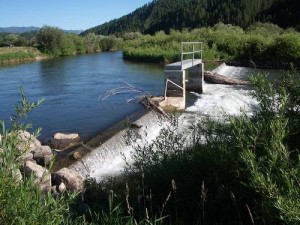Salt River: Speeding Tickets and Collaboration
by Cory Toye, director, Trout Unlimited’s Wyoming Water Project
I get a speeding ticket almost every time I drive through the Snake River Canyon on my way to the Salt River basin in western Wyoming. I am not sure if it is the 55 mph speed limit or because I spend a lot of time watching the river below me work its way through walls of rock, big plunge pools and riffles. But in 2010, I got the ticket because I was on my way to a float trip down the Salt River.
I guess I was a little excited. Not only was this an opportunity to hook some fish, it was a recon mission with TU reps and the Wyoming Game and Fish Department to identify potential habitat projects on the Salt, a great Wyoming fishing destination and a stronghold for native Snake River cutthroats. Thanks to a partnership with Orvis, TU received funding to take a closer look at the drainage to identify conservation work in the Salt River to reconnect historical habitats, improve fish populations and work with landowners on collaborative solutions. .
Although sympathetic, the highway patrolman didn’t change his mind about the citation.
The float trip was a success by all measure and the folks involved all shared a keen interest in finding ways to improve the fishery. We floated for two days through all kinds of surroundings, catching some healthy cutthroats and browns in search of the monster trout that locals talk about hooking. Although the monsters eluded us, we managed to a gain a new perspective about potential projects that could improve the fishery and enable native and wild trout populations to persist.
After discussing various opportunities we identified the first project—the need for a fish ladder on an irrigation diversion to provide passage for all fish in the drainage. This diversion was the only barrier for fish movement between Palisades Reservoir and the town of Afton.
This one bottleneck was preventing native and wild trout from accessing miles of prime habitat. Fix this, and we could improve the fishing up and down the Salt.
In 2011 we launched the fish ladder project, which opened up an astounding 20 miles of mainstem habitat and 240 miles of tributary habitat for fish trapped below the diversion structure. After project completion, we undertook a fish movement study to measure the success of the project and to determine how many fish were lost to the river system by being drawn into the irrigation canal. Through a partnership with the water users, TU and the WGFD tagged over 300 fish to monitor the movement of the fish near the diversion and determine that the ditch was not a significant drain on fish numbers.
Moving forward, more projects are coming online that will greatly benefit the native and wild trout populations in the Salt River. During fall 2013, TU and other project partners will install another ladder on a diversion barrier in an important tributary to the Salt River. Providing fish access to this important spawning and rearing habitat will improve natural recruitment and bolster populations throughout the drainage.
TU is grateful for the funding committed by Orvis for this project. This partnership is already making a difference, with projects that deliver lasting conservation benefits, and with studies that help us understand the long-term needs of the Salt River.
With any luck, I will continue receiving speeding tickets when I travel to the valley, and it will always be worth it. Fines and insurance premium increases don’t really matter when you are in a hurry to check on a new project or go fishing.


